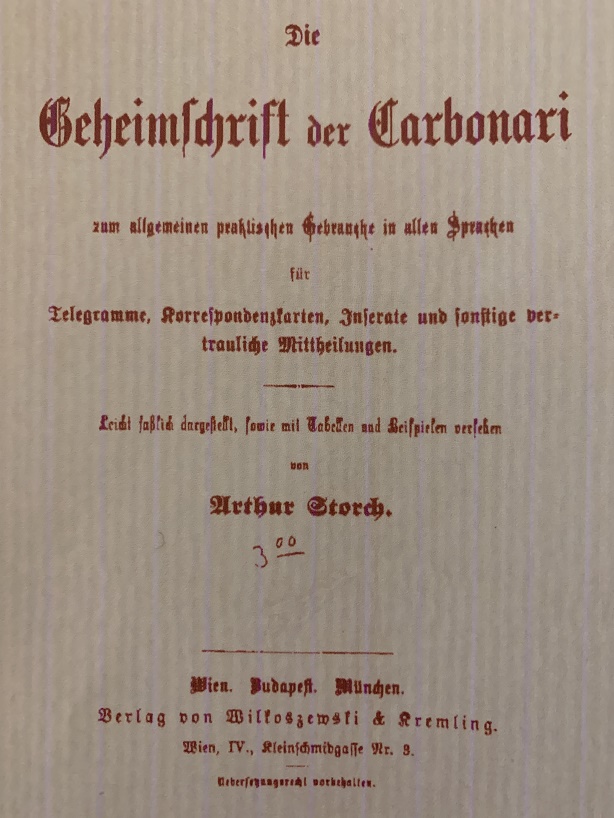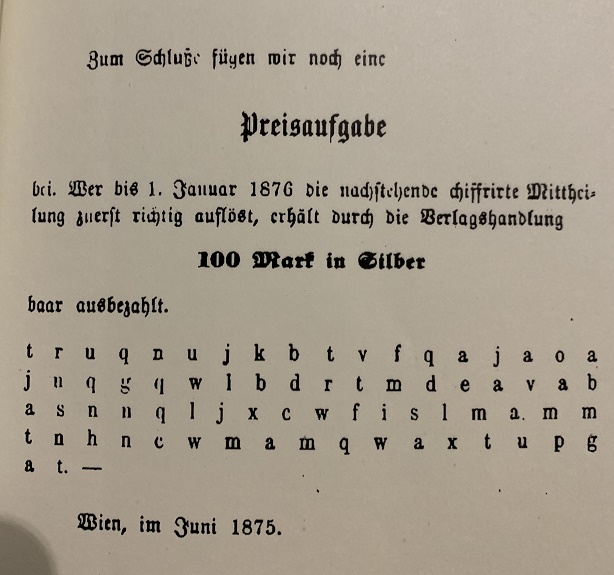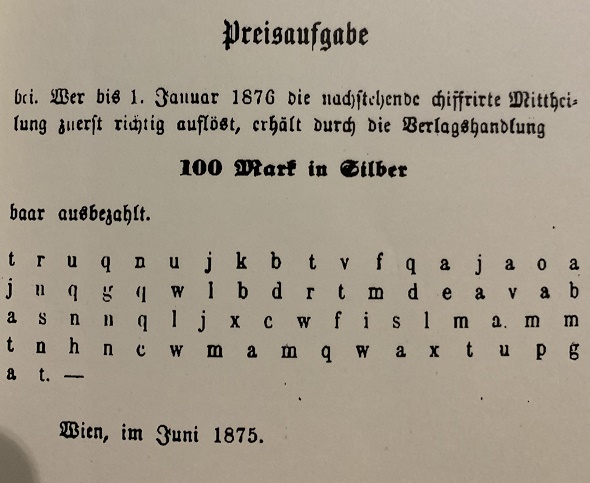In 1875 a German crypto book author published a cryptogram and promised to pay 100 Silvermarks to the first one who solved it. It’s probably to late now to win this prize, but I’m sure some of my readers are still interested in breaking this cryptogram.
Tobias Schrödel …

… , is known to many readers of this blog for his frequent appearances on Stern TV, a German TV magazine. Check here for an example. Tobias, who is a great speaker and comedian, is also known as Germany’s only comedy hacker.
On February 8, 2019, Tobias and I will give talks at the Kryptonight, an event organized by teacher Felix Brüstle at the Gymnasium Ottobrunn, a school in Ottobrunn near Munich. The Kryptonight is open for everybody, admission is free. Tobias and I hereby invite all readers of this blog who live in the Munich area to attend. The Kryptonight will start at 1900. Apart from the talks, there will be several showrooms with crypto devices and crypto puzzles. There is no Kryptonight website, but I will provide some additional information about this event on this blog soon.
The Carbonari cipher
Earlier this week, Tobias, who is also a crypto book expert and collector, informed me about a reprint of a crypto book from 1875 he recently purchased. It’s a book written in German titled Die Geheimschrift der Carbonari (“The Secret Writing of the Carbonari”).

The Carbonari (“charcoal makers”) were a network of secret revolutionary societies active in Italy from about 1800 to 1831. My Italian friend and crypto history expert Paolo Bonavoglia once told me about this organization and the ciphers they used.
The book Die Geheimschrift der Carbonari describes one of the ciphers used by the Carbonari – a variant of the Vigenère cipher. As most readers certainly know, the Vigenère cipher adds a keyword (e.g., LEMON) to the plaintext (e.g., ATTACK AT DAWN). Letters are added by interpreting them as numbers (A=1, B=2, C=3, …). If the result of an addition is greater than 26, 26 is subtracted. Here’s an example :
Plaintext: ATTACK AT DAWN Key: LEMONL EM ONLE -------------------------- Ciphertext: MYGPQW FG SOIS
However, the cipher described in Die Geheimschrift der Carbonari uses a different kind of addition. It is not clear how this addition works, as the original book contained an inlay that is missing in the reprint. Perhaps a reader can reconstruct this addition by looking at the following two examples given in the book:
Example 1:
TheodorHuberfallirtdieserTagegewisssalvirteuch romaromaromaromaromaromaromaromaromaromaromaro ---------------------------------------------- yhimoavtxnijmobpjxtxjkuwavmuniiejwvirdrsavigyh
Example 2:
TheodorHuberfallirtdieserTagegewisssalvirteuch abrahamabrahamabrahamabrahamabrahamabrahamabra ---------------------------------------------- hunmemvthqwqvmpqjjoxewjnjoagwvnezivibgfzjtwhpt
In addition, the author writes that the Carbonari cipher can also be used with the keyword (e.g. WIEN) used again from the start for each plaintext word:
The addition used here is the same as above. So, I don’t know how it works. Here is the ciphertext that results from this encryption:
FAAHLLN UBEWUGLJW WHAC VETJCWKATLL
BUNVFGXV JUNKAEMIVIXQ EABMWBR KWKJLXAWE ICLSTLF
The challenge
The book ends with a cipher challenge:

According to the book text, the first person to break this encryption is awarded the sum of 100 Silvermarks. Here’s the transcription Tobias provided me:
truqnujkbtvfqajaoa
jnqgqwlbdrtmdeavab
asnnqljxcwfislmamm
tnhncwmamqwaxtupg
at
I don’t know if somebody succeeded in deciphering this cipher text, but I’m pretty sure that now, after 144 years, it’s too late for winning the prize. Perhaps, my readers will try to break this cryptogram anyway. this might be difficult, as the algorithm used is only partially known, but I know that my readers are very skilled at solving mysteries like these.
Follow @KlausSchmeh
Further reading: How Edgar Allan Poe broke about 100 ciphertexts
Linkedin: https://www.linkedin.com/groups/13501820
Facebook: https://www.facebook.com/groups/763282653806483/




Kommentare (14)